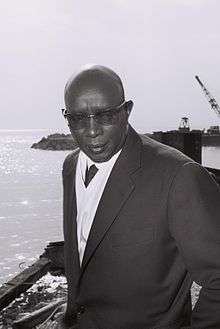Mwambutsa IV of Burundi
| Mwambutsa IV | |
|---|---|
| King of Burundi | |
 Mwambutsa pictured during a visit to Israel in 1962 | |
| Reign | 16 December 1915 – 8 July 1966 |
| Coronation | 16 December 1915 |
| Predecessor | Mutaga IV Mbikije |
| Successor | Ntare V Ndizeye |
| Born |
May 6, 1912 Nyabiyogi, Burundi |
| Died |
March 26, 1977 (aged 64) Geneva, Switzerland |
| Burial | Meyrin, Switzerland |
| Issue |
Charles Ndizeye (Ntare V) Rosa Paula Iribagiza |
| House | Ntwero |
| Father | Mutaga IV Mbikije |
| Mother | Princess Ngenzahago |
| Religion | Catholicism |
Mwambutsa IV Bangiricenge (6 May 1912–26 March 1977) was king (mwami) of Burundi who ruled between 1915 and 1966. He succeeded to the throne on the death of his father Mutaga IV Mbikije (r. 1908–15).[1] Born while Burundi was under German colonial rule, Mwambutsa's reign mostly coincided with Belgian colonial rule (1916–62). The Belgians retained the monarchs of both Rwanda and Burundi under the policy of indirect rule.[1]
Biography
Mwambutsa IV was born Prince Bangiricenge in c. 1912. Like other Burundian kings, he was an ethnic Ganwa (Tutsi). He became king, taking the regnal name Mwambutsa, on 16 December 1915 when he was still an infant following the death of his father in a family dispute.[1] Because of his age, a regency was declared. Several family members, including the Queen Mother Ririkumutima, served as regent. At the time of his coronation, Burundi was part of German East Africa but was captured by Belgium in 1916 during the East African Campaign in World War I. In 1925, a full regency council was established with Belgian approval.[1] Mwambutsa became a ruler in his own right on 28 August 1929.[1]
On the independence of Burundi in July 1962, Mwambutsa IV became the head of state of Burundi with far reaching political power. In Rwanda, the monarchy had been overthrown between 1959–62. He attempted to balance ethnic tensions between ethnic Hutu and Tutsi subjects by choosing his Prime Ministers from each ethnic group alternately.[1] In October 1965, Hutu officers attempted a coup d'état against the monarchy. Despite their failure to take power, Mwambutsa fled into exile in the Republic of the Congo, eventually moving to Switzerland. In March 1966 he designated his only surviving son to exercise his powers on the spot. Still in exile, Mwambutsa was officially deposed in a second coup d'état and brought his son to power as Ntare V on 8 July 1966. The monarchy was finally abolished altogether in a third coup in November 1966 and its leader, Michel Micombero, came to power as president and de facto dictator. Mwambutsa spent the rest of his life in Switzerland where he died in 1977.[1]
Mwambuta's remains were exhumed from their burial site in Switzerland in 2012 with a view to repatriating them to Burundi for a state funeral. After a legal battle, however, the remains were re-interred in Switzerland in 2016 in accordance with his family's wishes.[2]
References
- 1 2 3 4 5 6 7 Dictionary of African Biography 2008.
- ↑ "Court says remains of former Burundi king can stay in Geneva". Swiss Info. 1 November 2016. Retrieved 27 November 2016.
Bibliography
- Chrétien, Jean-Pierre (2008). "Mwambutsa IV Bangiricenge". In Gates, Louis, Jr.; Akyeampong, Emmanuel K. Dictionary of African Biography. Oxford: Oxford University Press.
| Mwambutsa IV of Burundi House of Ntwero Born: 1912 Died: 26 April 1977 | ||
| Regnal titles | ||
|---|---|---|
| Preceded by Mutaga IV |
King of Burundi 16 December 1915 – 8 July 1966 |
Succeeded by Ntare V |